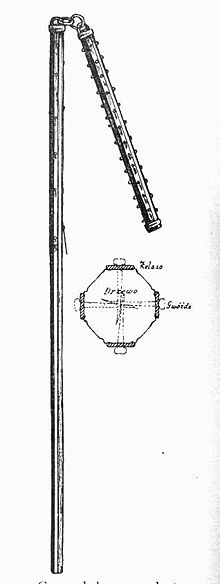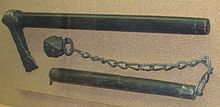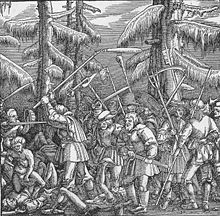- Flail (weapon)
-
This article is about the weapon. For other uses, see Flail (disambiguation).
The flail is a hand weapon derived from the agricultural tool. The handle is attached to the striking part of a weapon by a flexible chain or cord. Despite being regularly depicted as a common feature of medieval European warfare, only a limited amount of historical evidence exists for their employment in Europe during this era.
A two-handed flail of agricultural origin was used as a weapon of war in Germany and Central Europe in the later Middle Ages. This weapon consists of a hinged metal bar connected to a longer shaft (see illustration, to the right).
The Japanese term for their equivalent of the ball-on-a-chain bludgeon is "rentsuru", while the Chinese version's name translates vividly into English as meteor hammer.
Contents
History of the military flail
Throughout the Middle-Ages, two-handed agricultural flails were sometimes employed as an improvised weapon by peasant armies conscripted into military service or engaged in popular uprisings.
For example, in the 1420-1434 period, the Hussites fielded large numbers of peasant foot soldiers armed with flails.[1][2]
However, these weapons often featured anti-personnel studs or spikes embedded in the striking end,[citation needed] so they were not always simple agricultural tools snatched up in a hurry by rural insurrectionists: they could be purpose-built instruments of warfare, too, fashioned with professional skill by proper weapon-smiths.[citation needed]
The chief tactical virtue of the flail was its capacity to get around a defender's shield, by striking against the shield's edge with the tip of the main handle. The chain, cord or hinge would then let the striking end whip around behind the shield and strike the defender a forceful blow. Its chief liability was a lack of precision and the difficulty of using it in close combat, or closely ranked formations.
Accompanying the poem Le Chevalier Délibéré, written by Olivier de la Marche and first published in 1486, there is an anonymous woodcut depicting a knight carrying a rather simple morning star with spikes mounted in an asymmetrical pattern—as well as a flail equipped with a single spiked ball[citation needed]. The modified flail was also used in the German Peasants War in the early 16th century.[3][4]
At a later date, the long-handled flail is found in use in India, possibly more as a symbol of status than a weapon. An example held in the Pitt Rivers Museum has a wooden ball-shaped head studded with iron spikes. Another in the Royal Armouries collection has two spiked iron balls attached by separate chains.
Variations
The agricultural flail was not just used as an improvised weapon in Europe. In southeast Asia, short agricultural flails originally employed in threshing rice were adapted into weapons such as the nunchaku or sansetsukonn. Flails could easily be modified. Many were customized to be used with one hand by shortening the handle and chain. Multiple heads could be attached to the chain, or multiple chains with individual heads could be mounted to the shaft.[citation needed]
In modern history, improvised flails were also said to been used by members of organized crime during the Depression-era period of the United States and other Western countries. Known as a cosh, or blackjack, they are described as being made of a sock filled with sand, or a sock containing a bar of hard soap in the toe end, that were swung against the head of the victim with great but usually non-lethal force.[citation needed]
See also
References
- ^ Stephen Turnbull : The Hussite Wars 1419-36, Osprey MAA 409,2004
- ^ media:344Wagenburg der Hussiten.jpg media:Hussites massacre.jpg
- ^ Douglas Miller : Armies of the German Peasant's War 1524-26,Osprey MAA 384,2003
- ^ media:German Peasants War.jpg
External links
 Media related to Flails (warfare) at Wikimedia CommonsCategories:
Media related to Flails (warfare) at Wikimedia CommonsCategories:- Formal insignia
- Flail weapons
- Medieval weapons
Wikimedia Foundation. 2010.




